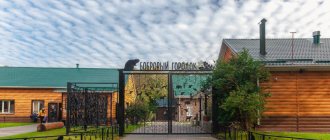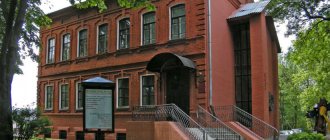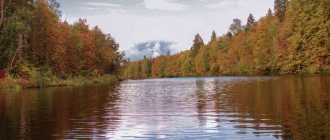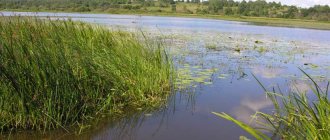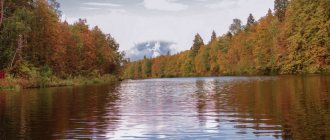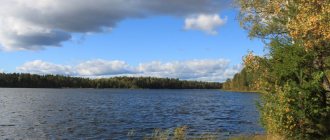Surprisingly, tourists rarely visit the attractions in Severodvinsk - the “city of northern shipbuilders”, the shipbuilding center of North-West Russia, in a picturesque place in the Arkhangelsk region, where the harsh White Sea receives the waters of the Northern Dvina. By the standards of Russian history, he is quite young. The settlement of shipbuilders, which gave it its beginning, arose already in Soviet times - in 1936. It was renamed several times, bore the names “Sudstroy” and Molotovsk, and the current one acquired in 1957.
The main attractions in Severodvinsk – TOP-5
First, about the most interesting places in Severodvinsk that you need to visit even if your visit to the city takes only one day.
Museum of the production association "Sevmashpredpriyatie"
- Address: Arkhangelskoe highway, 58.
In an industrial city, the main attraction, the center of life, everyday life and history is production - the city-forming enterprise. In Severodvinsk this is a shipbuilding plant, known under the abbreviated name "Sevmash".
He gained fame by making submarines. Of interest to tourists is the museum operating at the enterprise, which tells about the formation and development of local shipbuilding, the history of which is closely intertwined with the past of the entire city. The museum pays attention not only to “local subjects”, but also to milestones in the history and modernity of the Russian Northern Navy as a whole.
Many boys will be interested in ships; the museum’s exhibition will not leave them indifferent, offering an educational and exciting immersion in industrial and naval topics.
Nikolo-Korelsky Monastery
- Address: Arkhangelskoe highway, 58, building 75.
One of the few ancient attractions that reveals the history and culture of the area many centuries before the city was founded. According to legend, the monastery arose at the site of the death of two young people - Anthony and Felix, the sons of Martha the Posadnitsa from Novgorod. The grieving mother ordered a temple to be built here, consecrated in honor of St. Nicholas.
The temple complex operates to this day, and services are still held there. But the history of the monastery itself ended even before the city of Severodvinsk appeared on the map of the country. It was closed in 1920; by that time the monastery had a rich history and glory as a “cultural and educational” center of the northern region.
There was once a school here that taught children from the surrounding villages. In 1731, the most famous native of the Arkhangelsk land, Mikhail Vasilyevich Lomonosov, walked through the monastery. The history of the monastery includes the fact that it was the monastery convoy that helped the future luminary of Russian science get to Moscow.
Even in tsarist times, the monastery was used for the “exile” of unwanted people; this “unpleasant” function was performed by it even after its closure. The Soviet authorities set up labor camps here. From 1938 to 1961 the infamous Yarinlag was located here. Nowadays, part of the monastery premises is occupied by shipbuilding production.
Monument to M.V. Lomonosov
- Address: Lomonosov Square.
The Arkhangelsk lands and the territories of modern Severodvinsk are associated with the names of several famous people; the figure of Mikhail Lomonosov definitely stands apart in this list. Even though he did not live here, like many cultural figures, but only passed by, his figure is significant for the entire region.
The famous scientist and writer was immortalized in Severodvinsk in 1958. The local monument is one of the most famous sculptural incarnations of Mikhail Vasilyevich.
The monument by sculptor M. Aleshchenko and architect M. Nasekin is located at the intersection of Lenin Avenue with the street named after the scientist. The figure of the encyclopedist, 3.5 meters high, is mounted on a cylindrical concrete pedestal with a tablet indicating the years of his life.
Wheeled river steamer "N.V. Gogol"
The appearance of the city of shipbuilders would not be complete without shipbuilding monuments. An interesting city object that combines historical, educational and entertainment functions is a paddle steamer named after the great Russian writer Nikolai Vasilyevich Gogol.
The thing is that the ship, manufactured in 1911, is still on the move and is used for tourist boat trips. The ship became a pleasure ship in the early 70s. after major reconstruction. Before that, it regularly served for the benefit of the people, carried out cargo transportation, and during the Second World War it was used to transport the wounded.
Kudemskaya narrow gauge railway
- Address: pos. White Lake.
For a tourist, a railway is a useful infrastructure facility that allows you to get to your travel destination. However, it happens that the railway track itself is already a historical and cultural attraction. This is exactly the case of Severodvinsk.
The Kudemskaya narrow-gauge railway passing here is officially included in the list of the ten most beautiful railway routes in the world. The history of the railway began in 1949, when its first section was opened. Carried out passenger and cargo transportation, primarily used for timber transportation.
The narrow-gauge railway still performs these functions today, although the scale of local logging production is currently modest compared to previous stages. Until now, the railway remains unelectrified.
Severodvinsk museums and theaters
Cultural recreation is an integral part of a tourist excursion. In Severodvinsk, tourists can visit several museums, a theater and a cultural center.
Local Lore Museum of Severodvinsk
- Address: Pionerskaya, 10.
The function of covering local history is sufficiently covered; according to some visitors, it is not inferior in this regard to the “profile” one - local history. However, even the city’s local history exhibition will find something to surprise the independent tourist.
Here the visitor will be told about the life and culture of the Pomor people, who lived in these places since ancient times, about the first settlements and the first seaport in the Russian North, located on the territory of present-day Severodvinsk. The museum's halls are dedicated not only to history and culture, but also to the nature of the harsh northern lands along the shores of the White Sea.
Both the exhibition of the local history museum and the building itself are noteworthy. It is an architectural monument and played an important role at the beginning of the city's history. There was a maternity hospital here, where people who could confidently call themselves the first indigenous people of Severodvinsk saw this world.
Museum of Exploration Work (VPK Edelweiss)
- Address: Oktyabrskaya, 37.
There is also an unusual museum in the city dedicated to search work. Its creation is connected with the activities of the local military-patriotic club “Edelweiss”. The main theme of the club is dedicated to the Great Patriotic War, including the search for remains and trophies of war times. Members of the club organized several search expeditions, and the findings became museum exhibits. The exhibition, which occupies five halls, has been operating since 1995 and is considered the first of its kind in the Arkhangelsk region.
MAUK Severodvinsk Drama Theater
- Address: Lomonosova, 77.
The Severodvinsk Theater began its existence almost simultaneously with the city. In 1937, the artists first appeared on stage, presenting to the public a production based on the play “The Liar” by Carlo Goldoni. Since then, the following works have been performed on the theater stage of Severodvinsk:
- W. Shakespeare and L. Tolstoy,
- F. Dostoevsky and V. Nabokov,
- M. Gorky and A. Chekhov,
- Lope de Vega and other classics.
The Drama Theater is a good place to relax with children in Severodvinsk; the local troupe’s repertoire includes more than 10 children’s performances. The city theater is famous not only for its performances; it also hosts excursions, as there is a museum attached to it, which will be interesting for both children and adults to visit.
Shipmaker's House
- Address: ave. Lenina, 14.
One of the centers of cultural life in Severodvinsk bears the characteristic name “House of Shipbuilders” and serves as a city palace of culture. This is the most famous concert hall in the city, a venue for events of various types.
Creative groups from Severodvinsk and other cities in the region perform here, artists of “federal scale” tour, show programs and children’s parties are held.
The building of the House of Culture - a typical example of Soviet architecture - adorns the main city square with its majestic appearance. At the entrance, guests are greeted by the most popular monument of all Soviet and Russian cities - Vladimir Ilyich Lenin.
“I didn’t want to lose my loved one”
I had no intention of moving from Krasnoyarsk. My city suited me quite well, especially since recently it began to develop even faster. But fate decreed otherwise. I got married and had to move to Severodvinsk. My husband works at a factory here.
I couldn’t stay in Krasnoyarsk. This meant losing a loved one, and so I finally decided to completely change my life. I moved right after I finished my sixth year of medical school. Here I entered the Northern State Medical University for residency in otorhinolaryngology. It is located in Arkhangelsk.
Sights of the surrounding area of Severodvinsk and parks
The harsh northern nature has always attracted true aesthetes; it fascinates, enchants, exalts. Severodvinsk has several natural attractions and parks that are definitely worth seeing for travelers.
Embankment named after Alexandra Zryacheva
- Address: emb. named after Zryachev.
Severodvinsk is a coastal city and port. It is located not on any body of water, but on one of the northernmost seas of Russia. The White Sea in all its glory opens from the city embankment, which has become a popular place for walking for locals and tourists. There are observation decks for admiring the views.
You can not only walk along the embankment, but also ride a bicycle; there are bicycle paths here. The coastal area is decorated with replicas of ship cannons. The embankment bears the name of an honorary citizen of the city, the legendary shipbuilder Alexander Zryachev. A memorial sign was erected in his honor.
Dvina Bay
- Coordinates on the map: 65.056347, 39.000116.
Severodvinsk is located on the shores of one of the four largest bays of the White Sea, it is called Dvinskaya Bay. It got its name from the largest local river flowing into the White Sea. In addition to the Northern Dvina, many other small rivers merge with the sea here.
The depth in the bay reaches 120 meters, but shallow areas are also known, for example, the so-called “Dry Sea”. We are talking about a picturesque, vast, dry sandbank. It is interesting that Dvinskaya Guba, along with Onega, is one of the warmest areas of the White Sea.
Yagry Island
- GPS coordinates: 64.613677, 39.821679.
The center of natural attractions and monuments in Severodvinsk is Yagry Island, located at the mouth of the Northern Dvina River. This is a favorite place for recreation and fishing. Tourists and townspeople are attracted by the Yagrinsky pine forest, which stretches along the sandy shore.
Centuries-old trees create a peaceful atmosphere. This is a great place for those who like to walk in picturesque places and be alone with nature. Not far from Yagry Island there is a whole group of small uninhabited islands; wildlife lovers will be able to feel like “northern Robinsons”.
Chayachye Lake
- Coordinates on the map: 64.604683, 39.811770.
There are several fresh water bodies on Yagry Island, the largest of which is an oblong lake. In honor of the popular local monasteries, it was named Chayachye. The lake is home to not only seagulls, but also ducks, which vacationers love to feed. Here you can also see an interesting sea animal – the otter.
Park of Culture and Recreation
- Address: Sovetskaya, 30.
Severodvinsk Culture and Leisure Park is a standard place for city events, entertainment and walks. It “grew up” on the site of the city park, laid out in 1951 at the intersection of Profsoyuzov Avenue and Sovetskaya Street. The square was intended for the recreation of townspeople; a dance floor was organized here, and standard sculptures were installed.
The object became increasingly popular, and in 1972 it officially became a cultural park. The appearance was complemented by a beautiful fountain. Then attractions began to operate here, and over the years their variety increased. The most popular is still the Ferris Wheel. It has been taking vacationers on rides since 1990.
“Many people drive expensive cars”
Prices for food and things in Severodvinsk are approximately the same as in Krasnoyarsk. I didn't notice much of a difference. The shops are still the same: there are many hypermarkets of large chains. But real estate is very expensive. Two-room apartment with European layout of 40 sq. m costs 3.8 million rubles.
I was also surprised that many wealthy people live in such a small and somewhat unprepossessing city. I have never seen so many premium cars anywhere.
At the same time, I noticed that the residents of Severodvinsk are accustomed to saving. Many of them are quite scrupulous in financial matters; the salaries of the majority of the population are far from high. But, on the other hand, they know how to appreciate what they have. They are kind, honest and friendly and are ready to help even strangers. So I receive support here not only from loved ones, but also from unfamiliar people.
Temples and churches of Severodvinsk
As in other cities of Russia, there are many churches in Severodvinsk and its environs, although in terms of their number it cannot compare with Ryazan, Smolensk or Tula.
Trinity and St. Nicholas churches in Nenoksa
- Address: Nenoksa village.
It is difficult to imagine the Russian north without monuments of wooden architecture. Not far from Severodvinsk, in the small village of Nenoksa, there is a complex of two churches. Their history goes back several centuries.
Unlike the city of Severodvinsk, Nenoksa is an ancient village; the prototypes of local churches are rooted deep in history. It is known that from time immemorial there were three churches on the territory of the village, which burned down in the 18th century. The fire dates back to 1725. After him, the construction of temples began, which we can see today - in honor of St. Nicholas the Wonderworker and the Life-Giving Trinity. The first temple is winter, the second is summer. Bishop Varnava blessed the local residents for the construction of the shrine, and a carpentry team led by Vasily Korsakov arrived in the village.
First, the summer Trinity Church appeared; St. Nicholas Church, according to the official version, was completed only in 1763, but the date of its illumination is not known for certain. Until the beginning of the 19th century, the church was heated in black. The architectural appearance of the temple ensemble was completed by the bell tower, built in the 1830s.
Church of the Resurrection on Yagra
- Address: Zoya Kosmodemyanskaya, 2.
The Church of the Resurrection of Christ in Severodvinsk is a neat wooden church, painted soft blue, its domes covered with gilding. In design, it resembles a familiar example of northern wooden architecture, but its original appearance was probably somewhat different. The prehistory of this temple is shrouded in darkness. The fact is that the church does not stand in its historical place.
The church was moved to Yagry Island in the city of Severodvinsk in the early 1990s from the village of Solza. This decision was driven by the desire to save money. It was necessary to organize a parish for believers, and the construction of a new temple required a lot of money. During the transfer of the church, the Icon of the Resurrection was discovered, which became the main shrine of the temple and gave it its modern name.
Church of the Vladimir Icon of the Mother of God
- Address: Lebedeva, 16.
In the southern part of Severodvinsk, not far from the banks of the Kudma River, this new temple is located. The date of laying the first stone in its foundation is considered to be 2005; in 2006, the domes of this shrine were already consecrated. The Vladimir Church is small, but very cozy - there is always a friendly atmosphere, the ministers are responsive, and the parishioners are decent. The inside of the temple is beautiful - indeed, it creates the atmosphere of the house of God. There is a Sunday school for adults and children; on holidays, the parish can host exciting fairs and even concerts.
Chapel of the Blessed Prince Alexander Nevsky
- Address: Boychuka, 4.
The modern religious building became a decoration of the city in 2015. The chapel, located on Boychuk Street, near the city square, attracts with its elegant architecture; stained glass windows add grace to its appearance. One of them reproduces the image of the ancient Russian holy prince Alexander Nevsky, whose name the chapel bears. From a distance, a huge gilded dome crowning a small round building attracts attention.
Walk around Severodvinsk: monuments and memorials
The monuments of the city of Severodvinsk display the history and glorious past, and they also show tourists famous personalities for the northern town.
Memorial Stone to Richard Chancellor
- Address: Alexander Zryachev embankment.
Richard Chancellor is an English navigator of the 16th century; in 1553 he visited the Russian shores of the White Sea, visited the village of Nenoksa and the Nikolo-Korelsky monastery. His visit to Russia served as the beginning of trade relations between our country and the British. For this, the captain's name went down in history. In the city of Severodvinsk he was awarded a memorial sign, which was installed on the Embankment.
Sculptural and memorial composition “Peace and Labor”
- Address: David Pashayev Square.
In 1988, the city of Severodvinsk turned half a century old. On this occasion, sculpture masters A. Dem and V. Onezhko built a composition dedicated to the labor glory of the shipbuilding city. According to the author, the monument symbolizes the present, past and future of the city. The sculpture received the inspiring Soviet name “Peace-Trud-May” and became one of the symbols of Severodvinsk.
Military memorial complex "Grieving Motherland"
- Address: st. Richard Chancellor.
The pine forest on Yagry Island is not only a beautiful corner of nature, but also a memorable historical place where soldiers of the Karelian Front are buried. A total of 103 are known to be buried. A memorial complex was erected at the burial site. Its name evokes associations with the legendary monuments of Kyiv and Volgograd.
The local motherland is called the “Mourning One” and looks more modest. The composition consists of two stylized bayonets and a female figure standing humbly with her head bowed. She symbolizes a mother who lost her sons. The height of the monument is 12 meters. It was installed in 1975.
To the innocent victims of Yagrinlag
- GPS coordinates: 64.498461, 39.698767.
The tragic pages of the Gulag directly affected Severodvinsk. In memory of the political prisoners held in a correctional facility on the territory of the monastery, a stele was erected in the city. It is located on the site of a former cemetery, in one of the remote urban areas. The author of the attraction, G.A. Sodomovsky, created the monument as laconic as possible - in the form of a white rough stele.
The crew of the submarine Kursk
- Address: Yagry Island.
The tragically famous nuclear submarine "Kursk", which crashed in 2000, "originally" came from Severodvinsk. It was produced at a local shipyard. The city immortalized the memory of the 118 sailors who died in the disaster. The stela with the image of a submarine resembles a tombstone.
Excursion underwater vehicle "Neptune"
- Address: Arkhangelskoe highway, 58.
In 1991, for the first time in the history of our country, a submarine intended for tourist excursions was manufactured. It was produced according to the design of the Rubin design bureau.
The submarine was named after the ancient Roman underwater god Neptune. The 28-meter-long vessel is capable of diving to depths of 30 to 60 meters. In 1992, the facility was put into operation and went to work - taking tourists far from their homeland - to the waters of the Caribbean Sea. Four years later, the device was returned home for repairs, but the submarine never returned to its direct duties.
Muscovites wanted to take it and make a cafe, but these plans did not come true. Now the ship is still idle, being an object for tourist inspection. You can see it on the territory of the Sevmash plant.
Monument to the First Builders of Severodvinsk
- Address: First Moorings Street.
The monument located on the Yagrinskoye Highway, in the very place where the builders were landed in 1936, refers to the beginning of the history of modern Severodvinsk. They were sent here to build a shipyard for government needs. The pioneers were immortalized in the form of three bas-reliefs in red in 1978. The opening of the monument took place on the 40th birthday of the city of Severodvinsk. The author of the project was an aspiring sculptor from Leningrad, one of the students of the school. Mukhina.
On the topic of the article: overview of the sights of Kotlas, Solovetsky Islands, Kargopol and Arkhangelsk
The Soviet city grew up around the plant on the shores of the White Sea, in lands with a rich history that preserves the memory of the ancient Pomors and their culture. Today Severodvinsk is a town of shipbuilding glory, reflecting in its appearance the milestones of the country’s “maritime” and industrial history. The ancient heritage of these places and the wonderful picturesque nature of the Russian North add to their tourist attractiveness. Many people think that there is nothing to see in “industrial cities”. The sights of Severodvinsk prove that this is not the case at all.
Nikolo-Korelsky Monastery
One of the most ancient temples in the city is the Nikolo-Korelsky Monastery. At the end of the fourteenth century, fugitives left the north, hiding from the authorities and landowners in search of refuge. The Nikolo-Korelsky Monastery has stood since then. It was founded by St. Efim of Korelsky.
Since the primary structure of the temple was erected from wooden beams, it was not difficult for the Norwegians who came to the city with the war to burn it down. And in the seventeenth century, a new stone temple was erected on the site of the burned church. During the Stalinist repressions, many political prisoners found refuge here.
On the territory of the monastery there are now: St. Nicholas Cathedral, Bell Tower, Refectory and Assumption Church.

